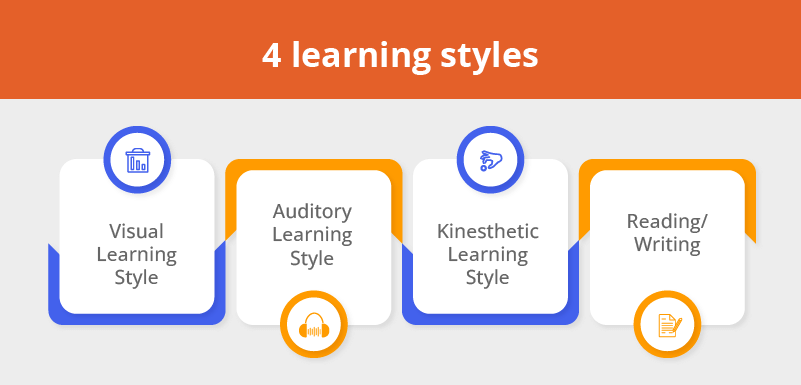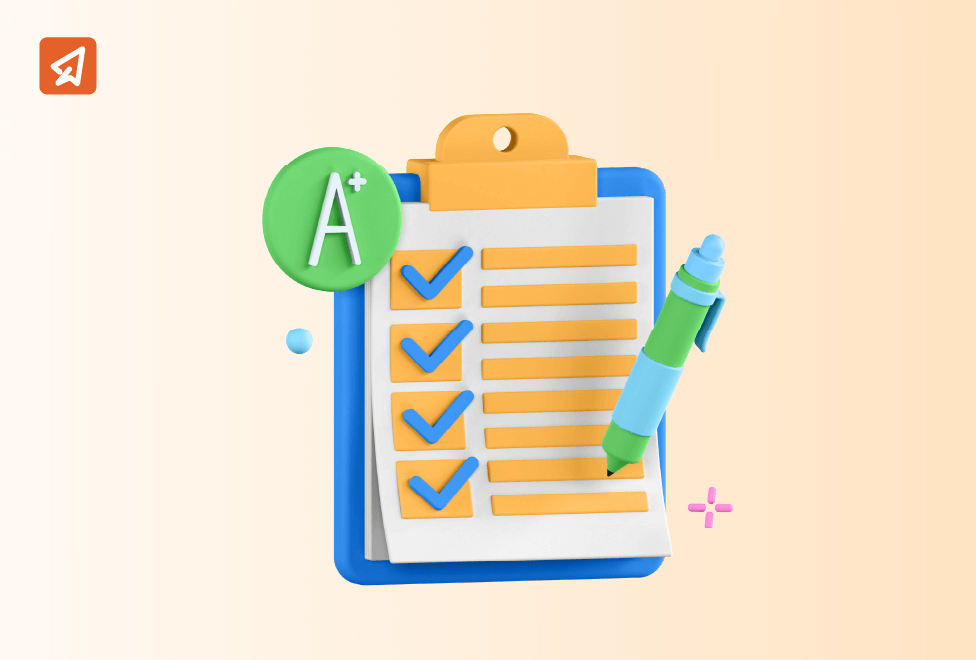What are the Different Types of Learning Styles According to the VARK Model

Various approaches are available for categorising learning styles, with Neil Fleming’s VARK model emerging as notably impactful. In 1987, Fleming developed an inventory designed to help students and individuals understand their distinct learning inclinations.
As per the VARK model, learners are classified according to their inclinations for:
- Visual Learning (utilising pictures, movies, and diagrams)
- Auditory Learning (engaging with music, discussions, and lectures)
- Reading and Writing (favouring tasks like making lists, reading textbooks, and taking notes)
- Kinesthetic Learning (preferring movement, experiments, and hands-on activities)
The VARK model revolves around four sensory modalities that express unique learning preferences. It suggests that these modalities act as cues, guiding students on how to enhance their learning experiences.
Different Types of Learning Styles – VARK

1. Visual Learning Style
Visual learners in the VARK model prefer to process information through images, videos, and diagrams. They learn concepts more effectively when presented with visual aids rather than through verbal or written instructions. This learning style emphasises the power of visual representation for better understanding and retention.
How to Spot Visual Learners?
Spotting visual learners is pretty easy. These are the kids who like to see and watch things when they’re learning. They enjoy using pictures, diagrams, and written instructions to understand stuff. Some call them “spatial learners.” To learn and remember things, visual learners might make lists, draw pictures, or take notes.
Here Are Some Signs of a Visual Learner:
- Notices changes in how things look, like people or spaces.
- Enjoys looking closely at things.
- Likes reading books by themselves and checking out images and diagrams.
- Asks a bunch of questions to make sure they understand.
- Doodles or scribbles while listening.
- Likes to keep things neat and organised, sometimes very carefully.
- Is good at art, music, dance, drama, puzzles, mazes, and spellings.
How to Teach Visual Learners?
Visual learners do well with things like pictures, diagrams, charts, maps, mind maps, and flashcards. Here are some effective ways to help them succeed:
- Show them images and diagrams to make things clearer.
- Use graphics and visuals to explain ideas.
- Write important stuff in front of the class to help them see it.
- Instead of just words, use colours and images.
- Encourage them to take notes and write down explanations.
- Highlight key points with colour or emphasis.
- Avoid using too much text at once.
- Include activities that let them draw mental maps.
- Use storytelling to help them visualise concepts.
- Colour-code and organise any materials you give them.
- Use phrases like “picture this” or “imagine” to encourage visualisation.

2. Auditory Learning Style
The auditory learning style involves a preference for learning through listening and hearing information. Those with this style process information more effectively when presented in an auditory format rather than visually or kinesthetically. Auditory learners succeed in environments that include lectures, discussions, group activities, and other methods involving spoken words and sound.
How to Recognize Auditory Learners?
As mentioned earlier, auditory learners are students who learn best when they hear things and connect them to sound. They prefer listening to lectures or recordings rather than taking notes in writing. These are the students who might talk through ideas or speak out loud before diving into them. The ones who often speak up in class are probably auditory learners. They might also read aloud to understand directions better.
Here are Some Signs of an Auditory Learner:
- Prefers sitting where they can hear well
- Good at remembering people’s names
- Enjoys music and often sings, hums, or talks while studying
- Likes talking and listening to stories
- Excels in grammar and foreign languages
- Is skilled at spelling verbally but struggles with writing
- Often has messy handwriting
- Is a great storyteller
- Points at words while reading or listening
- Easily remembers information presented in an interesting way
How to Teach Auditory Learners?
- Focus on listening activities
- Encourage speaking and class discussions
- Repeat important information verbally
- Use sound recordings
- Employ mnemonic devices (memory aids)
Effective Ways to Support Auditory Learners:
- Provide visual comparisons and metaphors to enhance understanding.
- Engage students in class discussions to promote participation.
- Suggest audiobooks for required reading.
- Allow them to play music while studying.
- Record your lessons or make them available online for flexible learning.
- Facilitate discussions with peers to explore concepts.
- Encourage verbal problem-solving.
- Advise them to read their notes aloud at home.
- Incorporate rhyming and mnemonic techniques.
- Enhance storytelling by playing relevant sounds during explanations.
Customise the learning journey of every student and engage every learner through Personalised Learning. Read more to learn more about the personal learning in 21st-century education.
3. Kinesthetic Learning Style
Some people like learning by doing things and moving around – that’s called kinesthetic learning. They learn best when they can touch and experience things hands-on. So, using their sense of touch and staying active helps them understand and remember stuff better.
How to Spot Kinesthetic Learners?
Kinesthetic learners learn best by doing and experiencing things. They often act out scenarios and talk with their hands, using their bodies to help them learn. In class, a kinesthetic learner might seem fidgety or clumsy. They’re good at following instructions in games or dances, and if someone is a great athlete or dancer, they might learn best by moving around.
Here are Some Signs of a Kinesthetic Learner:
- They wiggle, tap, swing their legs, bounce, and just can’t sit still.
- They remember things best when they’re doing something.
- They talk with their hands or make gestures.
- They like to be dressed comfortably.
- They want to touch things and try new stuff.
- They’re not big fans of reading or spelling.
- They’re really good at physical activities like running, swimming, dancing, and sports.
How to Teach Kinesthetic Learners?
- Include movement in lessons.
- Use things they can touch and feel.
- Show models or use materials.
- Let them physically interact with what they’re learning.
- Use hands-on activities.
- Give them chances to practice and experience things.
Ways to Help Kinesthetic Learners Succeed
- Have lessons that involve physical activities and hands-on experiences.
- Activities that involve walking or standing still work well.
- Since writing is physical, give them tasks where they can write down their thoughts and solve problems.
- Find a spot with enough room for them to write and create.
- Encourage making graphs, maps, and diagrams.
- Let them interact with real objects or solve puzzles.
- Try role-playing.
- Use real-world examples, like case studies.
- Suggest they do some activity while reviewing their notes.
- Ask them to teach parts of the lesson to other students.
- When you want them to imagine something, describe the feelings they might have. For instance, “Imagine the wind strongly hitting your body.”
4. Reading/Writing
People who like reading and writing learn best when they see information in words, like writing it down or reading it. Words are more powerful for them than pictures or sounds. They do really well on things like writing assignments.
How to Know if Someone is a Reading and Writing Learner in Class
Reading and writing learners like learning through words, but sometimes it’s mixed with visual learning. Even though it might seem like they’re learning through pictures, they actually prefer expressing themselves by writing. They enjoy keeping journals or diaries and reading articles. These learners may be experts at using encyclopedias and search engines to find information.
Traits of Reading and Writing Learners
Here are some things that reading and writing learners usually do:
- They like reading by themselves.
- They study better alone in quiet places.
- They are good at taking notes and organising their study materials.
- Writing essays, reports, and answers is something they enjoy.
- They learn well from dictionaries, thesauruses, or manuals.
- They are usually good at grammar.
How to Teach Reading and Writing Learners
These learners do well with:
- Reading
- Writing
- Taking detailed notes
- Rewriting notes to review
- Seeing information presented in words
Effective Approaches to Help Reading and Learners Succeed
- Use writing exercises and give instructions verbally.
- Ask them to present information.
- Use memory tricks or acronyms.
- Have the class read aloud in different ways, not just monotone.
- Let them teach certain knowledge to classmates.
- Include quizzes and tests in lessons.
- Encourage them to reread and rework their notes, including summaries.
- Provide lists of keywords for them to review.
Ignite Diverse Minds: Transform Your Classroom Today!
Break the mold of traditional teaching! Dive into the VARK Model’s secrets and see how a smart classroom can cater to diverse learning styles.
Learn More about Extramarks Smart Class PlusOther Types of Learning Styles
Besides the VARK models, there are some other learning styles as well. Let’s take a look at what they are:
1. Logical/Analytical Learners
These are the thinkers who love logic and figuring things out. They look for connections and patterns in what they’re learning. Teachers can keep them excited by asking questions that need thinking, giving problems to solve, and letting them draw conclusions based on facts or reasoning.
2. Social/Linguistic Learners
These learners enjoy teaming up and talking with others. They get the most out of lessons that involve working with peers. For them, it’s not just about learning but also about socialising. Teachers can keep them interested by using role-playing and group activities and encouraging students to interact by asking questions or sharing stories.
3. Solitary Learners
These are the independent ones who like to do things on their own. They prefer studying alone and don’t need a lot of interaction. Teachers can support them by giving tasks that involve individual work, like keeping a personal diary or solving problems on their own. Recognising their personal achievements is a great boost for them.
4. Nature Learners
Nature lovers! These learners thrive when they’re close to nature. They learn best in calm and relaxing outdoor settings. If being outside isn’t always an option, teachers can still tap into this style by giving hands-on activities, taking classes outdoors when possible, and using examples from nature when explaining new lessons.
How Smart Classrooms Cater to Various Learning Styles?
By creatively integrating tech and tools such as the ones offered with Extramarks Smart Class Plus, teachers can transform their classrooms into dynamic learning environments that cater to the diverse learning styles represented in the VARK model.
Smart classrooms are perfect for all learning types because of the following points:
- Flexibility: Smart classrooms allow teachers to easily switch between different learning modalities within a lesson, catering to mixed learning styles in a class.
- Accessibility: Utilize features like closed captioning for videos and screen readers for text to accommodate diverse learning needs.]
- Personalized Learning: Smart classroom technology often allows for individualized instruction and practice, catering to each student’s learning style.
Closing Thoughts
To sum it up, when you bring in the VARK model and different learning styles into your teaching, it’s like really understanding your students’ needs at a deep level. It’s not just about teaching one way and hoping everyone gets it; it’s about recognising that everyone learns a bit differently. This way of teaching makes sure no one feels left out and helps students not only understand better but also enjoy learning. As we keep going in the world of education, making sure we see and cater to these different styles becomes crucial. It’s not just about school stuff; it’s about sparking a love for learning that stays with students long after they leave the classroom, setting them up for a life of curiosity and success.
Last Updated on February 7, 2024
Reviewed by

Prachi Singh | VP - Academics
Prachi Singh is a highly accomplished educationist with over 16 years of experience in the EdTech industry. Currently, she plays a pivotal role at Extramarks, leading content strategy and curriculum development initiatives that shape the future of education...read more.











